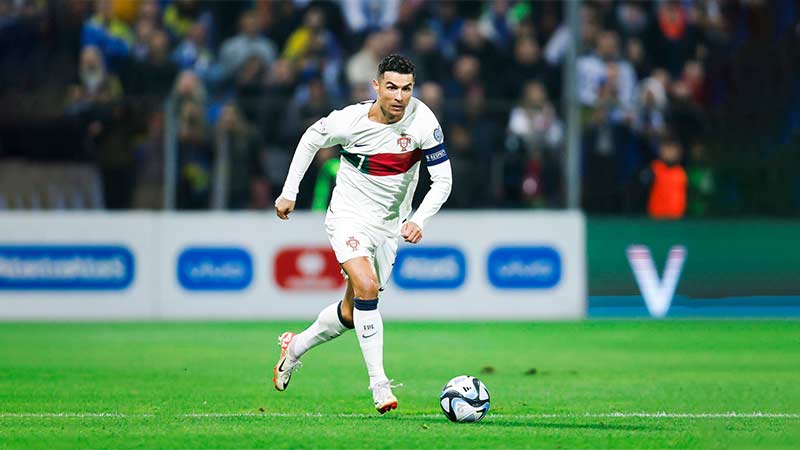Most soccer players rely heavily on the standard shot, but this limits their effectiveness on the field. Mastering different types of soccer shots can significantly enhance a player’s versatility and scoring potential.
This article delves into seven essential soccer shots, offering insights into when and how to use each one for maximum impact.
Whether you’re a beginner looking to boost your shooting skills or an experienced player aiming to diversify your game, understanding these techniques is crucial.
From powerful strikes to delicate finishes, each shot has its own unique application and can be a game-changer in the right situation. Let’s explore these seven types of soccer shots that every player should know to elevate their performance on the field.
Exploring the 7 Types of Soccer Shots
Mastering various soccer shots can significantly elevate a player’s game. Each shot type serves a specific purpose and can be the key to outsmarting opponents and scoring goals.
1. Laces Drive
A driven shot with the laces is the most common shot in soccer. The player strikes the ball with the laces of their shoe, aiming for maximum power. This shot is ideal when close to the goal or taking long-range strikes. Precision and strength make it difficult for goalkeepers to save.
2. Placed Shot
A placed shot is typically executed with the inside of the foot. This controlled technique is used when a player aims to place the ball in a specific area of the goal, often away from the goalkeeper’s reach. It’s especially effective in close-range situations where accuracy outweighs power.
3. Chipped Shot
A chipped shot delicately lifts the ball over the goalkeeper’s head. Players use this when the goalkeeper is off their line, creating an opportunity to score with a soft, lofted ball. Mastering this technique requires finesse and an understanding of the goalkeeper’s positioning.
4. Volley
A volley is a shot taken without letting the ball touch the ground. Players commonly use it when receiving a cross or when the ball is airborne. This shot requires timing and technique to strike the ball accurately mid-air, often leading to spectacular goals.
5. Half-Volley
A half-volley involves striking the ball just as it bounces off the ground. This shot combines elements of volleys and ground shots, offering players a quick and powerful way to take advantage of a bouncing ball. Proper timing is essential to ensure a clean, forceful strike.
6. Bent Shot
A bent shot curves the ball, either to the left or right, using the inside or outside of the foot. This technique is useful for curling the ball around defenders or goalkeepers, especially during free kicks or when aiming for the corners of the goal.
Control and spin are key factors in executing a bent shot effectively.
7. Toe Shot
A toe shot uses the tip of the foot to strike the ball, often resulting in a quick, unexpected release. This shot is less common in professional play but can be effective in close-range situations where a rapid strike is needed.
It prioritizes speed over precision and can catch goalkeepers off guard.
Techniques and Tips for Mastering Soccer Shots
Mastering various soccer shots enhances a player’s ability to score goals. Proper techniques and situational awareness are crucial for success.
Perfecting Your Technique
Proper technique improves the accuracy and power of soccer shots. Focus on the following key aspects:
- Body Position: Maintain balance by leaning slightly forward when striking the ball. This stabilizes the body and maximizes control over the shot.
- Foot Placement: Place the non-kicking foot parallel to the ball, ensuring it points towards the target. This alignment aids in delivering a more accurate shot.
- Strike Zone: Hit the ball with the intended part of the foot, whether it’s the laces, inside, or outside. For instance, use the laces for a powerful drive and the inside for a placed shot.
- Follow-Through: Continue the motion after the ball is struck, keeping the body relaxed. This ensures the ball maintains its intended trajectory and speed.
Choosing the Right Shot in Different Scenarios
Different game scenarios call for specific types of soccer shots. Use the following guidelines to select the appropriate shot:
- Laces Drive: Use this for long-distance shots, particularly when there’s space to generate power. It’s effective from outside the penalty box.
- Placed Shot: Ideal in one-on-one situations with the goalkeeper. Aim for the corners of the goal to make it difficult for the keeper to reach.
- Chipped Shot: Useful when the goalkeeper is off their line. Chip the ball to loft it over the keeper’s head into the net.
- Bent Shot: Employ this in free-kick situations or when looking to curl the ball around defenders. It’s effective for targeting the far post.
- Volley: Execute this when the ball is in the air, either from a pass or rebound. It’s high-risk but can be highly effective for surprise shots.
- Half-Volley: Hit the ball just as it bounces off the ground. It combines power and control, making it suitable for quick reactions in crowded penalty areas.
- Toe Shot: Use this for quick, unexpected shots, especially in tight spaces. It requires minimal backlift, making it ideal for surprise attacks.
Different shots suit different situations and refining these techniques improves overall performance on the field.
Training Methods for Soccer Shots
Practicing different types of soccer shots improves a player’s versatility and performance on the field. This section covers drills, advanced techniques, and training aids to master soccer shots effectively.
Drills for Practicing Soccer Shots
Using varied drills enhances the ability to execute different kinds of shots under game conditions.
- Target Practice Drills: Set up cones or markers in the goal to simulate target areas. Players practice hitting these targets, improving their accuracy for shots like the Placed Shot or Bent Shot.
- Shooting Under Pressure: Simulate game scenarios where defenders apply pressure. This drill helps players make quick decisions and execute shots like the Toe Shot when space and time are limited.
- Power Shots: Practice shooting from long distances to develop strength and precision for the Laces Drive. This drill focuses on using the laces part of the foot to generate maximum power.
- One-on-One Drills: Create situations where the player faces just the goalkeeper. This improves situational awareness and decision-making for shots such as the Chip Shot or Placed Shot.
- Combination Play: Involve passing sequences that culminate in a shot on goal. This drill mimics game dynamics where shots often result from quick passes and teamwork.
Advanced Techniques and Training Aids
Incorporating advanced training methods and aids accelerates skill development in various soccer shots.
- Video Analysis: Recording training sessions provides visual feedback. Reviewing footage helps players identify areas for improvement in their shooting technique.
- Weighted Balls: Using slightly heavier balls during practice builds strength and improves the power of shots, particularly for the Laces Drive.
- Resistance Bands: Attach bands to the player’s legs to add resistance during shooting drills. This increases leg strength and enhances control over powerful shots.
- Simulation Software: Advanced software allows players to simulate various game scenarios. This tool helps in understanding spatial dynamics and selecting the appropriate shot type under different conditions.
- Biomechanical Analysis: Utilizing biomechanical analysis tools offers insights into body positioning and movement patterns. This high-tech approach optimizes the mechanical aspects of executing different soccer shots.
These training methods, when combined, form a comprehensive approach to mastering various soccer shots. Players can refine their technique, enhance accuracy, and improve overall performance by systematically practicing and integrating these drills and aids into their routine.
Frequently Asked Questions
What are the seven essential types of soccer shots mentioned in the article?
The seven essential types of soccer shots discussed are the Laces Drive, Chipped Shot, Inside Foot Curled Shot, Outside Foot Shot, Volley, Half-Volley, and Toe Poke. Each serves specific purposes in scoring goals and can significantly enhance a player’s versatility on the field.
How can I improve the accuracy of my soccer shots?
Improving accuracy involves practicing specific drills like Target Practice and Shooting Under Pressure. Employing advanced training aids such as Video Analysis and Weighted Balls can also provide feedback and help refine your technique.
Why is body position important when taking a shot?
Body position is crucial because it affects balance, power, and accuracy. Proper body alignment ensures that your shots are both powerful and accurate, making it more likely to score goals effectively.
What role does foot placement play in perfecting soccer shots?
Foot placement determines the trajectory and power of the shot. For example, striking the ball with your laces generates power, while using the inside of the foot can offer more control and curl.
Are there any specific drills mentioned to improve shooting under pressure?
Yes, the article mentions the Shooting Under Pressure drill, which simulates game scenarios to enhance decision-making and accuracy when faced with defensive pressure.
Conclusion
Mastering various soccer shots is crucial for player success, allowing adaptation to different game situations and increasing scoring opportunities. Proper body positioning and foot placement are essential for executing these shots effectively.
Incorporating drills, advanced tools, video analysis, and weighted balls enhances accuracy and decision-making.
Dedicating time to mastering different shot types, such as powerful drives and finesse chip shots, ensures versatility and unpredictability, making players formidable opponents. Consistent practice and focus on technique are key to achieving this mastery.
By diversifying their skill set, players can surprise defenders and goalkeepers, increasing their chances of finding the back of the net. Each shot type, whether it’s a curling shot or a volley, serves a unique purpose in a game.








Brice Petersen